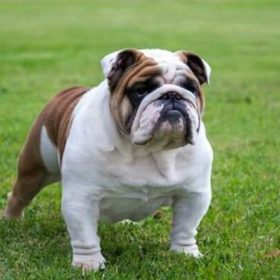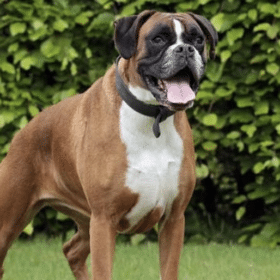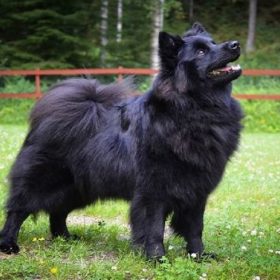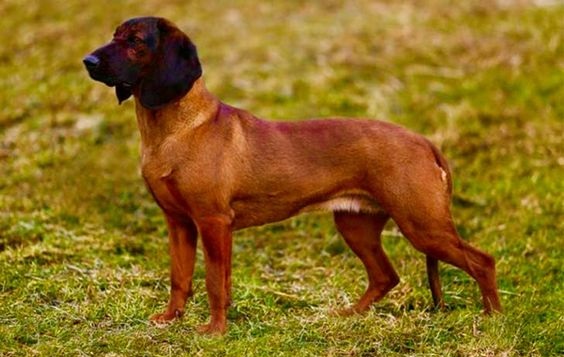Bavarian Mountain Hound

The Bavarian Mountain Hound is considered a dog of one owner, madly attached to the family and ready to be faithful to him for life. Likes to be in the spotlight and constant company, not ready for solitude. Other pets, unfortunately, do not get along.
Table of Contents
Breed Information
| Another Name | Bayerischer Gebirgsschweißhund |
| Origin | Germany |
| Height | Males 47-52 cm Females 44-48 cm |
| Weight | 25-35 kg |
| Fur | Short |
| Color | Red, tiger |
| Lifespan | 10-12 years |
| FCI Classification | Scent hounds and related breeds |
| Group | Hunting dogs |
| Price | From $1000 |
Breed Photos
Origin History
The Bavarian Mountain Hound was explicitly bred for mountain hunting in Germany in the 18th century. The breed owes its origin to the Bavarian Baron Karl-Bebenburg Reichenhall, who dreamed of a helper ideally suited for mountain hunting and did his best to create an ideal bloodhound. The renowned Hanoverian hound was able to find his prey following a blood trail immediately, but the baron was not happy with it as it was not suited to work in the mountains. The decision to cross the Hanoverian hound with the German Bracke bore fruit. A new perfected mountain hound was born. The combination of service characteristics and high-quality work in the mountains was so successful that the breed quickly became popular among Germany’s avid hunters. The year 1912 became a decisive year in the breed’s development – it was officially recognized, and the Bavarian Mountain Hound Club was established. But fame lasted not for long; after the world wars, the breed was practically extinct. Cynologists restored the breed piece by piece and gave it a second life. Today, it is more popular as a service dog in Germany and the Czech Republic, Poland, and Slovakia.
Appearance
Bavarian Mountain Hounds are considered a large breed. The average hound weight can exceed 25 kg; at withers, they reach up to 52 cm. The distinctly muscular body with a strong neck and strong legs makes it hard to forget what the breed was bred for. The skull is broad, the ears are set high and drooping, wide at the base, with rounded tips. The mountain hound’s wool is short, thick and shiny, moderately stiff, and close to the body. It is shorter on the head and ears, longer and coarser on the belly, paws, and tail. Dogs of this breed have the most varied coloration, from light walnut to dark brown. At that, usually, ears and muzzle area are colored in shades of gray and black; also, there may be inclusions of red or white colors.
Character
The Bavarian Mountain Hound is considered a dog of one owner, madly attached to the family and ready to be faithful to him for life. Likes to be in the spotlight and constant company, not ready for solitude. Other pets, unfortunately, do not get along. Due aggression to strangers and suspicious types does not show, except that the mountain hound will be re-trained as a guard dog, it is not destined to become an excellent guard dog. It is very hardy and willing to work for hours, truly happy to feel during a hunt or super endurance training.
Care
The ideal owner for a Bavarian Mountain Hound is a hunter or woodsman who lives out of town all the time. Only many hours of game walks or activities can calm the energy rushing through. The coat’s care is not time-consuming, intensive combing with a massage brush only during the molting period. The ears are considered the vulnerable part of the hound; their floppy shape promotes the appearance of infections or parasites, so you must keep an eye on them.
Training
The stubbornness and stubbornness of the Bavarian Mountain Hound create barriers to perfection. For such a pet with a stubborn character, you need an experienced specialist during training. Puppy socialization should be started at the age of three months, no later. The best activity for a dog is hunting, don’t forget that. With proper and regular training can be used in the police service.
Common Diseases
The musculoskeletal system is the weak point of the Bavarian Mountain Hound. Members of this breed are prone to elbow and hip dysplasia. Common conditions include various eye problems. Inadequate ventilation of the ear canal contributes to the chronic course of infectious inflammation common to all breeds with floppy ears.
Nutrition
A Bavarian Mountain Hound requires a responsible approach to nutrition. A balanced diet will have the necessary ratio of proteins, fats, and carbohydrates for a working dog. Such dogs need daily physical activity, and therefore constantly require the reserve of energy needed for effective exercise and regular life activity. During the cold season, it is advisable to increase the consumption of animal fats. Less fat in the diet is compensated by increasing the proportion of carbohydrates. They are included in the menu in the form of cereal and vegetable dishes and toasted rye bread. It is soaked in broth, milk, or other liquid.
 Pont-Audemer Spaniel
Pont-Audemer Spaniel East European Shepherd
East European Shepherd Majorca Shepherd Dog
Majorca Shepherd Dog Bulldog
Bulldog Boxer
Boxer Swedish Lapphund
Swedish Lapphund


